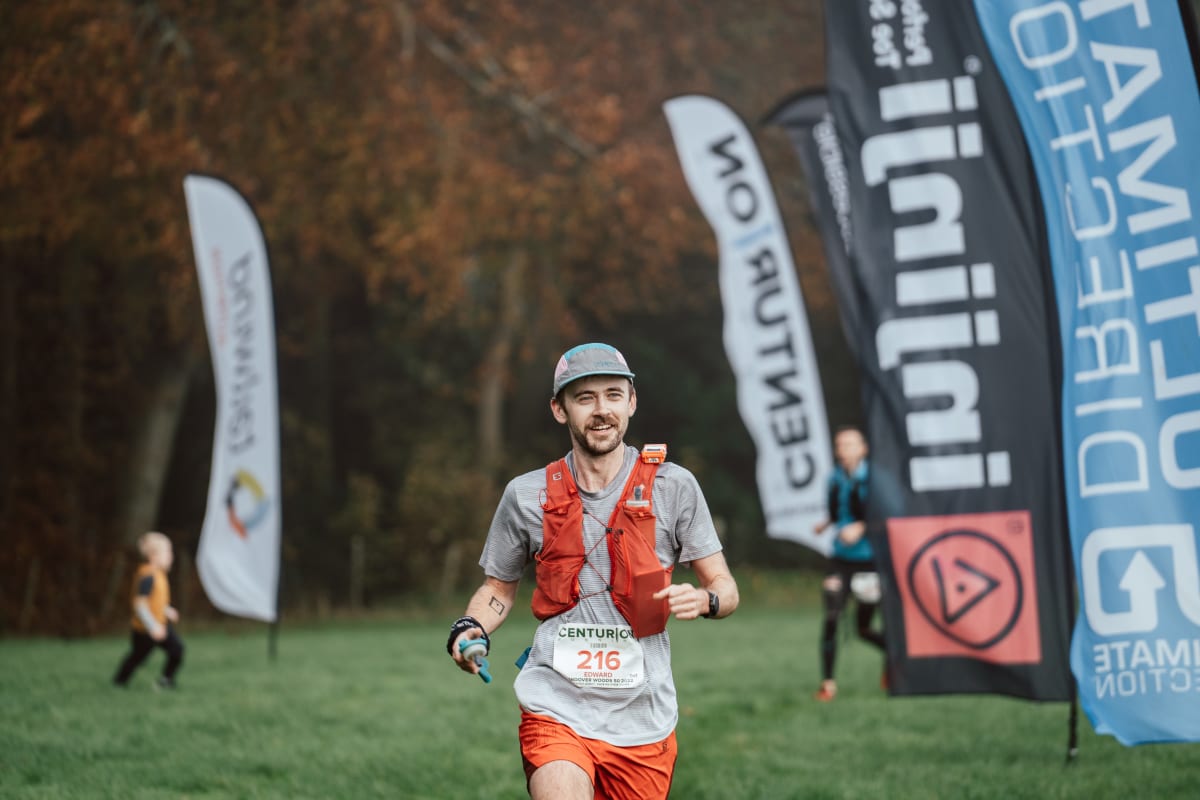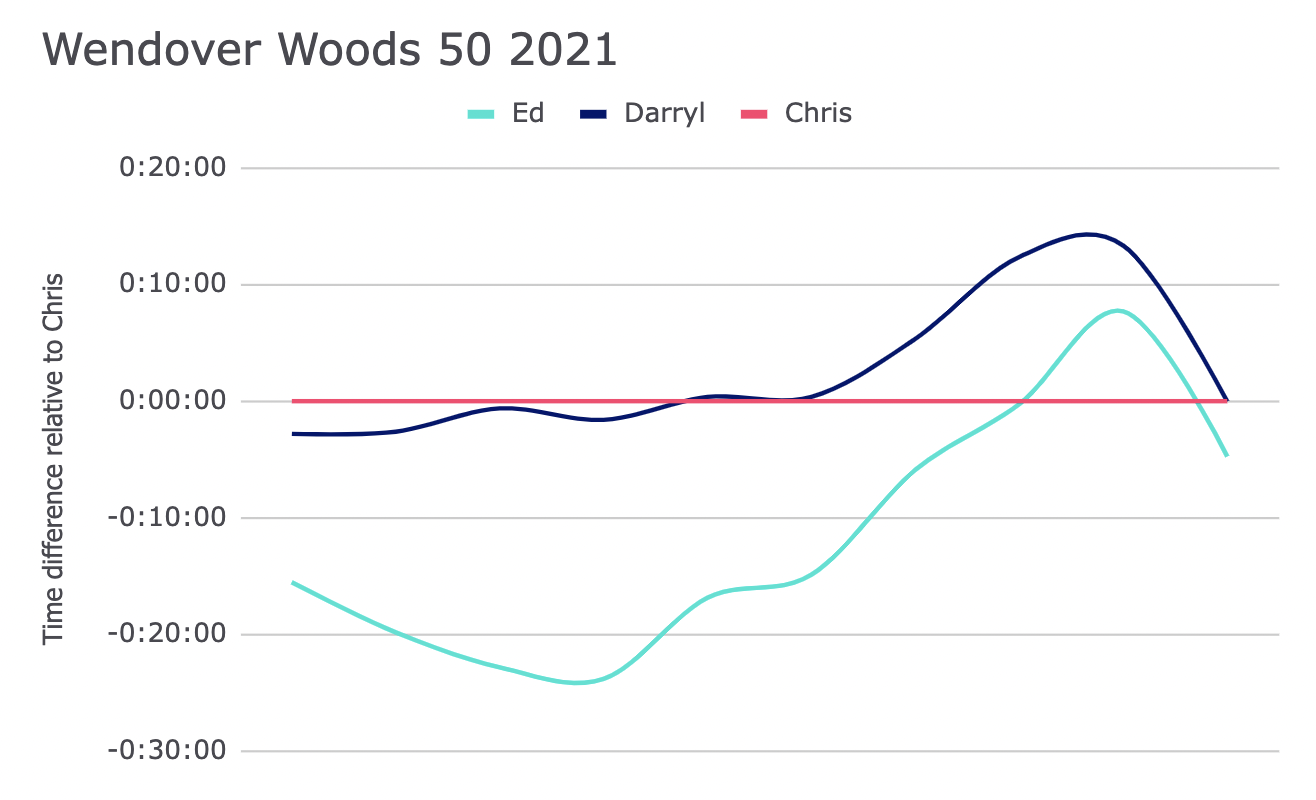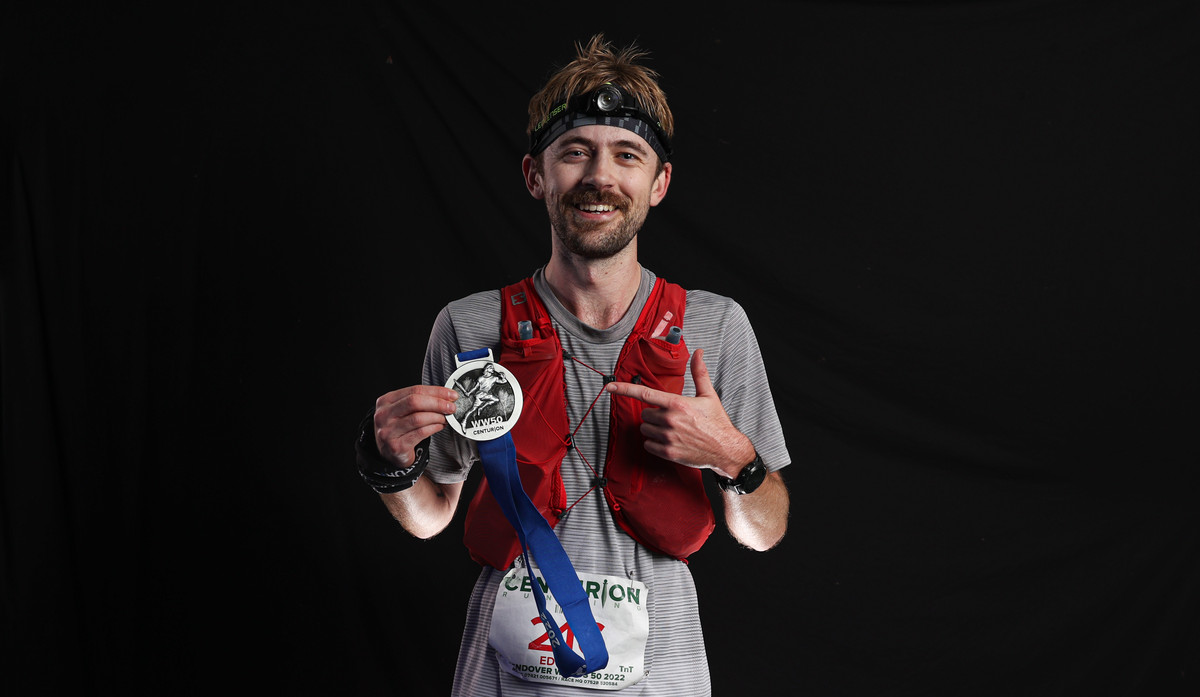Wendover Woods 50
Posted by Ed on November 20, 2022
It’s a mild November night. The world before me is a spotlight of illuminated trail, occasionally dappled by the hallucinatory shimmer of a falling leaf. A semi-conscious glance at my watch tells me I’ve been on the move for close to nine and a half hours, during which time I’ve covered 45 miles and climbed about 9,000 feet. The dog walkers have long since left – the forest belongs to the runners now.
‘Runner’, here, is a relative term. I round a bend in the trail, and one of the many steep climbs that pepper this course unfolds before me. A conga line of colourfully-clad zombies slaloms towards its apex. I pick my way up, occasionally grabbing on to nearby trees and roots.
This is the fifth time I have tackled this calf-busting ascent today, and it will be the last. Cresting it, I glance back down the slope, and watch a few headlamps slowly wind their way up towards me. I had so much been looking forward to this particular moment, being done with this climb, but, standing here, I feel a little flicker of loss at having ticked it off. Nonetheless, I give it a lazy middle finger and plough onwards.
The hard stuff is now truly behind me. All that stands between me and the finish is a few miles of runnable trail and one final climb. Safe in the knowledge that I am comfortably going to demolish last year’s time, I’m content to jog it in. Part of my attention is swirling around in the semi-conscious babbling of my brain, where Nick Shoulders croons and yodels on an endless loop; another part of me is attentive to the rustlings of the forest around me, and the quiet plod of runners up ahead. I am in neither of these places, and both.
As I pick my way down a root-strewn path, something intrudes upon this listless merry-go-round. As if a white sun were dawning, the foliage around me begins to light up, and my own shadow yawns towards me from the trail up ahead. Someone is closing in. Odd, I think, given how well my race has been going – I’ve only been overtaking people for the last few hours. As far as I can tell, I’ve only spotted one fellow fifth loop runner recently; all the rest I’ve been lapping on loop four.
Not wanting to get in the way of someone else’s good day, I step aside to let this surging runner pass, which he does at a breakneck pace. “Let’s fucking go, man!” he says, and before I can truly register what is happening, I am chasing him through the woods, my legs moving faster than I thought possible at this stage. “Shit,” I think, “this hurts.”
Let’s rewind a bit.

The Wendover Woods 50, often abbreviated as WW50, is a five loop, 50-mile race in Wendover Woods, Buckinghamshire, hosted by Centurion Running. Taking in 2000 feet or 600 metres per loop, the ingeniously-designed course extracts some of the best trail running terrain to be found just about anywhere in the South of England from a parcel of land just four square miles in area, mixing long, runnable sections with a handful of heart-stopping climbs. These climbs, and other sections of the race, are given names like ‘Gnarking around’, ‘Chiltern scree-ming’, and ‘The snake’. They’re brutal, steep, and seem to get longer with each lap.
Last year, Wendover Woods was the final event in the four-race 50-mile Grand Slam, and by far and away my favourite. Though I usually prefer point-to-point events for the sense of adventure and ‘going somewhere’ they impart, the atmosphere at WW50, with runners crossing paths and revisiting aid station crew time and time again, was so electric that I had to come back. The fact that I had some unfinished business to attend to may also have played a role.
For a full recap, see last year’s race report, but the TL;DR version is that, having spent the entire race slowly catching up with my buddy Chris, eventually (and unknowingly) overtaking him on the changeover between loops four and five, I experienced headtorch issues on my final lap which meant I spent a good ten minutes at the last aid station trying to source new batteries, during which time Chris arrived, saw my conundrum, and took off into the night. He eventually caught up with our mutual friend Darryl, whom I had met on the North Downs Way 50 earlier that year (and who makes excellent trail headwear), and pipped him to the finish line by two seconds. I was five minutes behind the two of them, finishing in 11 hours 35 minutes, having powered my way through the final five miles in a blind panic at potentially losing both my primary and back-up light sources.
With all three of us toeing the start line once again in 2022, it’s fair to say I was feeling competitive, though Darryl’s self-imposed goal of sub-10:30 seemed like a far-off ideal, given that it would mean running over an hour faster than last year.

In truth, I almost didn’t start this year. Recently my family have been dealing with some difficult news, which, without wanting to go into too much detail, meant I didn’t give much thought to running in the weeks prior to the race. In fact, I didn’t complete a single long run during the taper, barely running over 20km each week. Whilst I wasn’t particularly concerned about the physical impact of this inactivity on my performance, psychologically, I wasn’t sure if I had it in me to suffer through not only a 50-mile race, but a particularly tough one at that.
In the end, I opted to show up and see how things went. But my mindset was definitely altered.
I recently heard Courtney Dauwalter talking about her experiences in the ‘pain cave’, that lonely, agonising place runners go on long races. Rather than try to delay arriving at that place, or avoid thinking about it, Dauwalter faces it head-on, treats it as a place to be explored, seeks new depths within it. Usually I’m a conservative runner, but in this race I tried to emulate Dauwalter’s strategy, pushing from the off. When the suffering started, I kept it front of mind, not trying to distract myself or pretend it wasn’t happening. I asked myself, “What is this suffering like?”, trying not to categorise or compartmentalise what I was experiencing, but merely to notice it, experience it, and make adjustments if necessary.
This proved to be a powerful strategy. As the race unfolded, it became quite clear that the vast majority of the discomfort I was experiencing was surface level – a result of my own ego, or the linguistically proficient, control-seeking left hemisphere, trying to put an end to what it had short-sightedly determined was bad, without recognising the broader context in which the suffering was embedded.
On the Ridgeway section of lap one I caught up with Darryl, earlier than expected. We leapfrogged for a few miles, him invariably taking the lead on the downs, me taking it back on the climbs. Coming into the first aid station we caught Chris, and the three of us powered up the long hill towards the ‘Boulevard of Broken Dreams’ together, chatting and reflecting on just how hard we were pushing so early. And I certainly was pushing, coming into the first aid station a good twenty minutes ahead of last year’s split. Conditions were near perfect, which helped a lot, but it was also definitely the case that I was fitter, faster, and more confident on the steep stuff, perhaps thanks to the incomparable elevation I faced at Ring of Steall in September.
I left Darryl and Chris behind at changeover into loop two, stopping for barely 20 seconds to refill a single water bottle with Tailwind. This was a deliberate attempt on my part to put a bit of pressure on the two of them, but also on myself. I felt I would move a bit better if I knew I was being chased. Over the course of the next few hours, when neither of them surfaced, I began to relax somewhat, though never enough to slow up. With each passing aid station, I compared my times gleefully to the previous year’s splits on my phone, enjoying watching my ‘lead’ on my past self grow and grow.
By the time I got to the final Hale Lane aid station on lap five, I was well over an hour ahead of last year’s time, and knew that I would gain even more, as it was at this point in 2021 that I spent a good ten minutes standing still, trying to resolve my headtorch issues. Let’s return, then, to that moment in the final few miles where a headtorch surged into my periphery, and I stepped aside to let the runner pass. “Let’s fucking go, man!” he exclaimed, and before I knew it we were racing through the woods.
It took me a good few seconds to clock that this surging runner was, in fact, Darryl, who had spent over eight hours slowly clawing his way back towards me after I, quite literally, waved him goodbye at the end of lap one. (Regrettably, Chris made the wise decision to drop out halfway through loop three, battling a foot injury.) I distinctly recall feeling simultaneously elated by the sudden burst of action and slightly terrified at the prospect of racing to the finish after so many hours on my feet. We were truly booking it, running at 4:20/km pace or so along the winding trail, but when we hit the bottom of ‘Railing in the Years’, the long, handrail-assisted climb up to the finish, both of us slowed considerably, winded by our efforts.
It emerged that, on lap four, Darryl had been tipped off by Johno, a mutual friend of ours manning the Hale Lane aid station that I was only ten minutes ahead. By the time he rolled back around to the aid station on lap five, the news was the same – “Ed is ten minutes ahead.” Exasperated, but given a distinct advantage by knowing this fact, Darryl had laid down an incredible performance to make up the gap, where I had been merely content to jog it in. As we plodded along the single track trail that links ‘Railing’ to a turnstile just before the finish, I asked Darryl, quite sincerely, “Are we really going to race this?” I genuinely didn’t feel up to it – it turns out, neither did he.

In the end, I managed to put down one final kick, and pipped Darryl to the line by 15 quivering seconds. Which, across the course of 10+ hours, is absolutely nothing. More remarkable than that, however, is the fact that we both managed to beat 2021’s times by a huge margin – I took 90 minutes off last year’s run, and came 25th where last year I came 56th.

It was a truly exhilarating finish, and one that I know I’ll cherish for years to come. Competition is collaboration, and it was a huge pleasure to have the chance to force the very best out of one another in those final miles. I know I have more to give at this race, having made such a huge improvement on last year’s time. I plan to return to it in 2024, in its new guise as a summer event, and see if I can have a crack at making the top twenty – or, dare I say it, the top ten?
